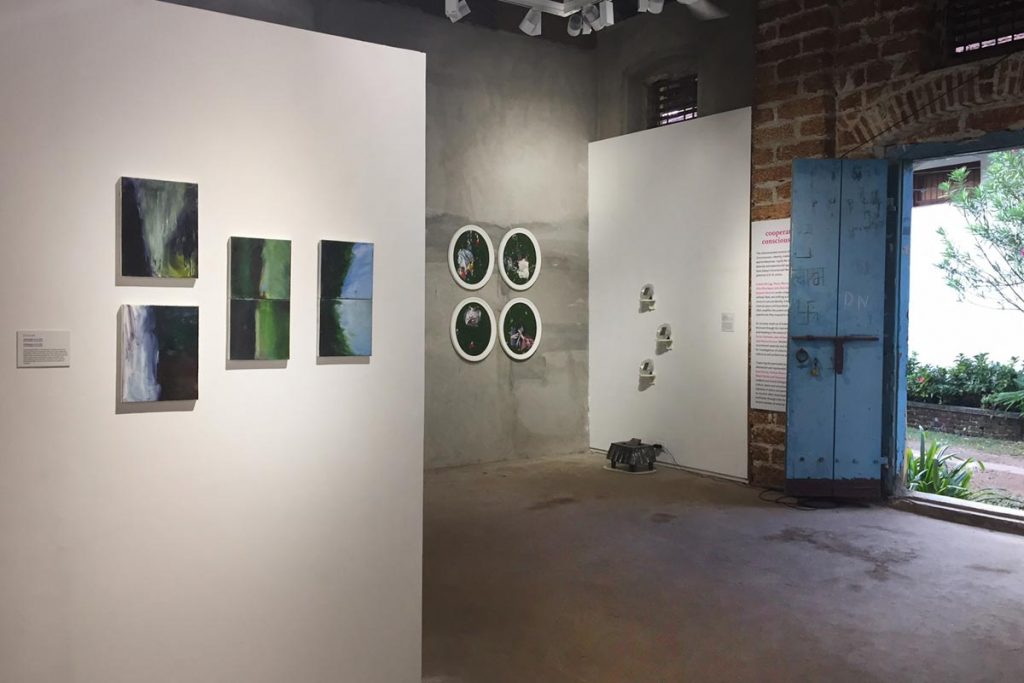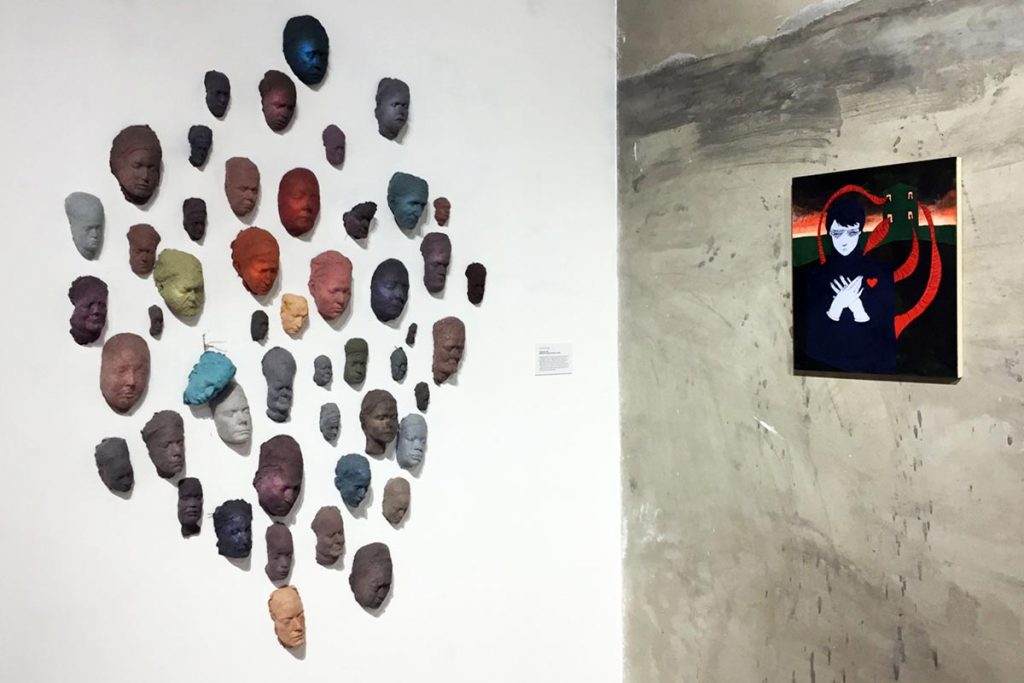
Contributed by Sharon Butler / Last year I visited Jayanthi�Moorthy‘s�studio�and suggested she get�in touch with Kathryn Myers, a UConn colleague of mine who has facilitated cultural exchanges with Indian artists, curated numerous shows of their work, and�participated in many exhibitions in India.�The two artists connected, and this year they curated “Cooperative Consciousness,” a group�exhibition at the�Kochi-Muziris Biennale featuring artists from the�A.I.R. Gallery in Brooklyn. Here’s the story of their exchange.

Sharon Butler:�What precipitated the collaboration on the�Kochi-Muziris Biennale ?
Kathryn Myers: After you suggested Jayanthi contact me, she�invited me�to see her�solo�exhibition at Brown University. After I saw the�show, she mentioned that she and the A.I.R. members were looking for a curator for the Kochi exhibition. I had been to two previous Kochi-Muziris Biennales,�so I was familiar with the exhibition and very interested in participating in the project. I had a friend who had organized a collateral exhibition, so I knew something about what was�required and how these collateral exhibitions were a part of the Biennale. Partnering with Jayanthi worked well. I worked on the selection of works and the curatorial statement, and she did the installation. We met in person only once and communicated mainly via email and a dropbox folder.
Jayanthi Moorthy:�I had proposed�the project to fellow A.I.R. members, and I was looking for a collaborator. After a couple of email exchanges with Kathryn, I realized�how deeply invested she was in the east-west dialogue, and I knew that we could work together. She said yes, and there was�no looking back. The one meeting we had in New York was very important in enabling us to understand each other�s temperaments, be aware of our respective availabilities, and chart out a basic project timeline. What kept the collaboration strong was how we understood each other�s roles, were committed to the project, and �communicated with ease — hundreds of emails and a few text messages.



SB: How did the process unfold? What were the challenges organizing a show in another country?
KM:�Jay had sixteen A.I.R. member artists who were interested in submitting works. I came up with three themes connected to Sudarshan Shetty�s curatorial statement and started writing the text for a printed brochure.�Once Jayanthi secured the gallery,�and we knew how much space we had, I selected works accordingly. Jay, who knows how things operate in India and has plenty of local contacts, handled all of the logistical details flawlessly, which was key since neither of us could be there for the entire duration of the exhibition.
JM: Spearheading the “Off-Site Committee” at A.I.R, I was looking at international exhibit opportunities for the gallery. When I was exhibiting in Kochi in February 2016, I was looking at opportunities for the gallery there. My gallerist friend gave me couple of space options in June 2016 and I chose one with less square footage but greater security. The challenges included:�deciding on a space, ensuring it was ready on time, contracting with a local shipping company in Kochi, factoring all overhead expenses into a budget, finding a local design production company to arrange the print publications required for the exhibition, and coordinating with the Biennale organizers to ensure our visibility. Kathryn�s connections with artists in India who had set-up collaterals during the last Biennale were very helpful. The next task was to get a substantial number of A.I.R. members to participate. This involved canvassing our New York, national, and alumni members about the opportunity. It was the first time many were exhibiting in Asia and there was a lot of skepticism among members about works arriving�safely and on time, dealing with customs, and figuring out best packaging practices for works to travel across the globe. The only way I could offset this fear was by assuring them that I would work closely with a shipping company personally�take care of shipping all their works. The other major challenge was in not having a dedicated team to help me work through this massive project. I had to assume various roles myself. These included graphic designer and media coordinator as well as overall program manager. I planned weekly events, generated audiences, did publicity, and procured materials for workshops. Our event series was called “Cafe Consciousness,” and it always had a tea stall set-up with freshly brewed tea and snacks that flavored the local culture. And since Indian merchants understandably wanted to be paid in cash, some financial improvisation was required.
SB: Is there any overlap in your own art making practices or are they quite different? Where is the common ground?
KM:�Our styles and methods of working are quite different but we both connect to Indian art and culture through our work. Jay�s work has a relationship to Indian craft and ritual traditions such as the creation of rice flour �kolams� � abstract diagrams made on the thresholds of houses every morning. My work responds to Indian architecture and space.
JM:�The common ground comes from the deep interest Kathryn and I share in making the east-west connection in our lives and through our work. Part of my work derives inspiration from ancient Indian cultural and ritual practice of drawing on the floor with impermanent materials like spices and rice flour, and in the process exploring various aspects of personal and cultural identity. Kathryn�s paintings, photographs, and video works are about architectural spaces in rural India. And I got an education about some of well-known Indian artists through Kathryn�s extensive documentaries.


SB: Do you think you might�continue to collaborate in the future?
KM: This was a very special project through which it was great to get to know and work with Jay. Both of us clearly have thick ties to India, so I�m sure we will keep sharing resources and our love of the country, and I hope we work together again.
JM: Yes I do! We both seem to have the same pace in our work styles � heavily multi-tasking yet responsive and committed to a common project. We both have a good understanding of the Indian mentality, which crucially enables us to be patient with processes and expected outcomes that are different from those in the United States. Also, Kathryn�s energy is infectious and inspiring.
SB: Is there anything else you would like to add?
KM: It was great to get to know the history of A.I.R much better through this project. It was a gallery I always knew about, but didn�t know its history thoroughly. To prepare for my curatorial statement I did a lot of research, reading prior articles and trying to understand the legacy of feminist or women-run galleries that were such a major part of the artistic climate while I was coming of age as an art student and artist. The Kochi-Muziris Biennale is a truly fascinating international art exhibition. Artists respond wonderfully to its setting (old buildings and warehouses throughout the city), and to the city�s history (global trade ties with the Dutch, Portuguese, and British, which are extremely evocative). Because of the biennale, Kerala�s reputation as a location of artistic activity has increased, and now the government, not just private individuals, is providing substantial support. It�s been a great boon to tourism as well.�As I�ve been an observer for two past biennales, it was great to be a participant and I�m grateful to you, Sharon, for introducing me to Jayanthi.
JM: This project was much more than just setting up an exhibit in another country. It was a way of not only enhancing A.I.R.�s international visibility as a successfully running women�s collective for last 40 years, but also of learning what the gallery is in its home country � an active space that opens up dialogues in art, feminism, and society through exhibits, discussions, and other community activities. During my four-week stay in Kochi, I organized seven artist talks whereby A.I.R. artists had cross-cultural dialogues with the local community on aspects of feminism related to gender, race, and identity. There were two panel discussions � one about the challenges of starting and maintaining a cooperative gallery (organized by Kathryn), and one on Kerala�s matriarchal society and what we could learn from it. There were three art educational workshops for college students that revolved around finding one�s personal and cultural identity, as well as one art-spiritual workshop for women. All in all, it was a remarkably rich experience that fully rewarded the effort.
The Kochi-Muziris Biennale is a people�s biennale where the local community � students, native artists, local businesses, etc. � is involved in running the show, and where the director, curator and organizers of the Biennale are easily accessible for a chat (there is no air about them being in those positions!). The Biennale must also be appreciated for using sustainable approaches towards exhibit spaces. The chosen venues are in historical buildings that are integrated with the neighborhood and the community and the spaces go through minimal changes to exhibit world class art ranging from hi-tech multimedia installations to traditional wall paintings.
�Cooperative Consciousness: A.I.R. Artists at Kochi,� With �Alisa Henriquez, Daria Dorosh, d�Ann de Simone, Jane Swavely, Jane Gilmor, Jayanthi Moorthy, Joan Snitzer, Jody Joldersma, Julia Kim Smith, Louise McCagg, Maxine Henryson, Melissa Furness, Mimi Oritsky, Nancy Morrow, Shannon Forrester, Yvette Drury Dubinsky. Curated by Kathryn Myers and Jayanthi Moorthy. A.I.R. Artists at Kochi, Gallery OED Cochin compound, Mattancherry, Kochi, Kerala 682002, India. Through March 28, 2017.
Related posts:
Indian studies: Kathryn Myers
Part I: Adira Thekkuveettil and the defaced murals in India
Part II: Adira Thekkuveettil and the defaced murals in India
Grounded in India

















Great. Art is a tested and proven way to build bridges between cultures.
Wish it could do the same for politics today.